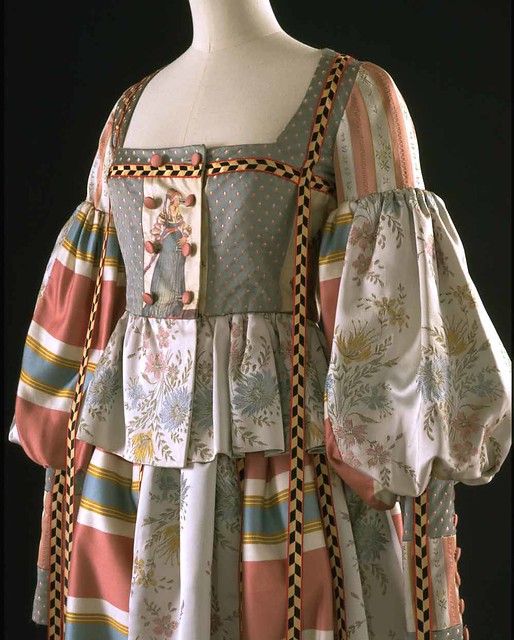
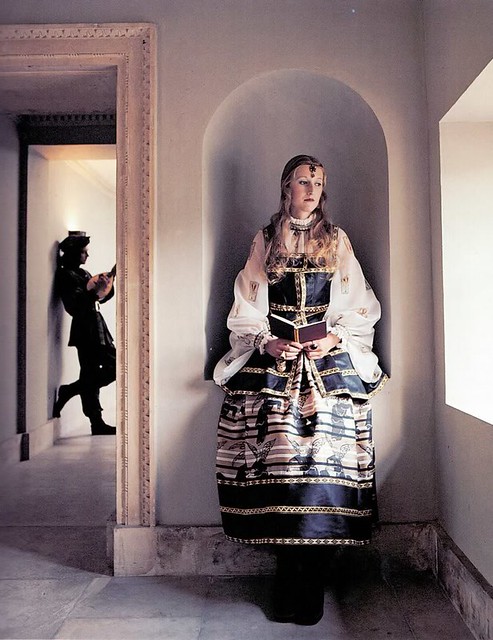
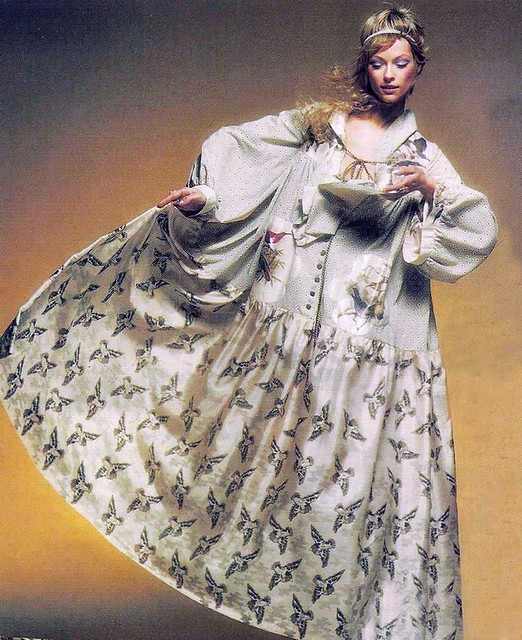
Top: Detail of Renaissance evening outfit, Bill Gibb, 1972, V&A
Bottom: Bill Gibb designs, early 1970s
Before I became a student of art history I was bewitched by the exuberant romance of Pre-Raphaelite paintings. The sensual drape of a fabric was evocative of a mood, an allusion to desires at odds with conservative Victorian society. The 1960s and 1970s witnessed a revival of the Pre-Raphelite mode of feeling, reflected in the clothing of the period.
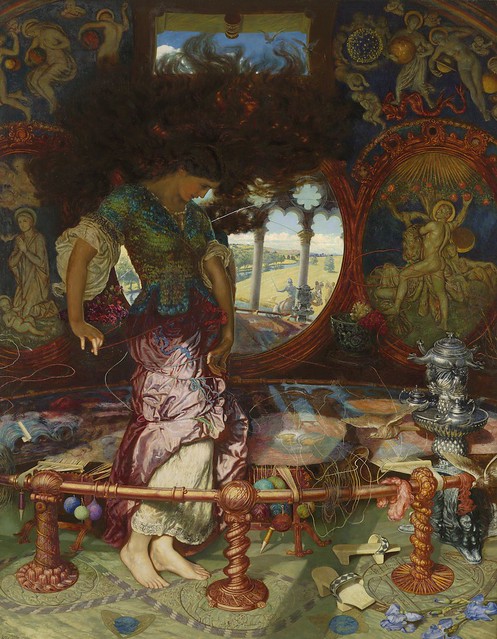
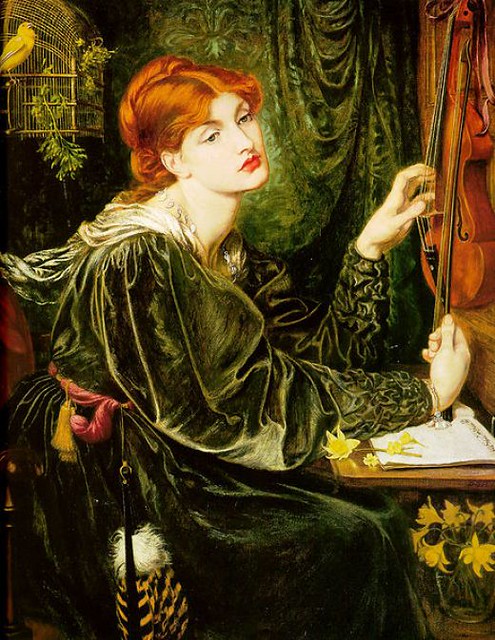
Top: The Lady of Shalott, c. 1886-1905, William Holman Hunt
Bottom: Veronica Veronese, c. 1872, Dante Gabriel Rossetti
As the 1960s entered their full swing, fashions became more daring as new vibrant chemical dyes flooded the market and fed the appetite for psychdelic prints. In this decade we saw the introduction of the womens liberation movement, and in response the hemlines became higher as women's dress became more outrageous. Toward the end of the decade, as austerity set in, a wave of ennui hit the younger generations, who witnessed the destruction of many historic buildings as the downside of rapid urbanisation and modernisation became apparent. Responding to the rapid population growth in urban areas, high rise concrete building began to dominate the skylines of the major cities, particularly London. The demand for social housing grew, and a generation of young people grew disenchanted with modern living, turning, as the Victorians did, to what they saw as a more rural, authentic way of living. In the cities they expressed this desire through their clothing. By the time the 1970s came round Victorian eclecticism shook out its extravagant skirts as it sashayed back into vogue. Enter Bill Gibb.

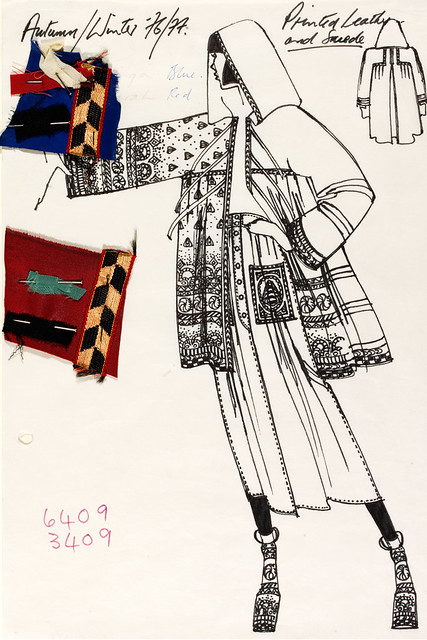
Top: Bill Gibb editorial, photographed by Sarah Moon from Vogue, January 1970 (source)
Bottom: Autumn/Winter 1976/77 designs from Bill Gibb, from the V&A
Bill Gibb's roots couldn't have been more pastoral. Born in rural Scotland in 1943, Gibb was the son of a dairy farmer. His talent for drawing was noticed by his art teacher, who encouraged the young Gibb to move to London in 1962 to study at St. Martins School of Art. He graduated first in his year and gained a scholarship to the Royal College of Art in 1966, where he studied under the legendary Janey Ironside. At the close of the decade, a number of key British talents emerged from the college, namely Ossie Clark, Zandra Rhodes, Anthony Price, and Gibb himself. Thus Gibb became an active member of the British Boutique Movement.
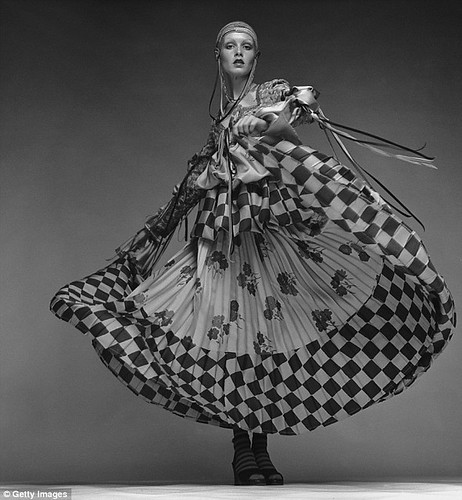
In 1971, Bill Gibb made a splash onto the international fashion scene as he dressed Twiggy (pictured) for her appearance at the premiere of Ken Russell's The Boyfriend, a movie in which she also starred. In 1972, he established his independent label, he debuted his first solo collection at the Oriental Club in London.
Gibb was unconventional, his designs responded to the growing romantic trend of the late 60s/early 70s, the free spiritness of the Woodstock generation personified this mood, and his creations took their inspiration from the Medieval Renaissance and the East. He combined rich fabrics, textures and hand embroidered patterns. Gibb’s most recognizable motif was a bee (B for Bill) which he utilized in the form of enamel bee buttons and knitwear with bee designs (how very Arts and Crafts!). Twiggy, Bianca Jagger, Anjelica Huston and Elizabeth Taylor counted among his celebrity following.

Bill Gibb with his models, 1970s (source)
By the 1970s Gibb was influenced by the Hippie movement, and the rising popularity of the 'handmade' artisan crafts. With his partner, the artist turned knitting guru, Kaffe Fassett, Gibb's knitted designs became what he was best known for. His designs and knitwear were undoubtedly influenced by his Scottish roots, and his love of history and fantasy. Like the Pre-Raphaelites before him, the costumes of the Renaissance informed and inspired his designs. The lure of the exotic also features heavily in his gowns, with luxurious fabrics, silks, leather and furs, translated into eclectic styles such as a hareem style trouser suit or a billowing Holbein print gown. The pastoral influence was never far away, with folk style dresses, evoking the fairy tales of Bavaria and Eastern European traditions. Just as the folk tales of Europe share common themes, the creative exchange between Gibb's Celtic eclecticism and Eastern influences met in a rich melting pot, where art became fashion.
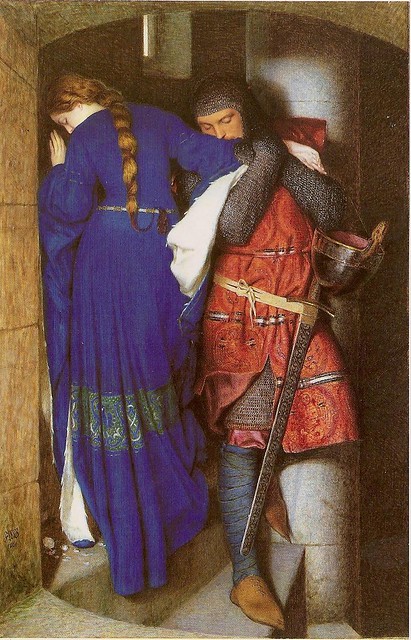
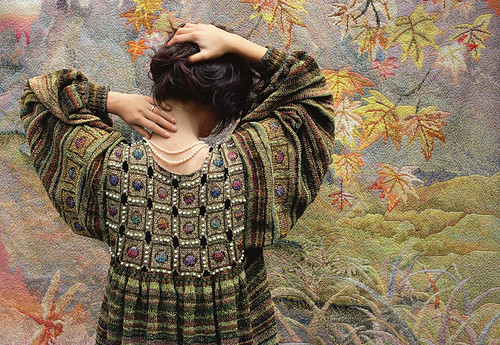
Top: Hellelil and Hildebrand the Meeting on the Turret Stairs, 1864, Frederic William Burton
Bottom: A Chenille and Lurex dress designed by Gibb, knitted by Kaffe Fassett with actual pearls, in front of one of Fassett's needlepoint tapestries (1970s)
The romance of the medieval beloved by his predecessors the Pre-Raphaelites, featured heavily in Gibb's designs. The revival of craft, first promoted in the nineteenth century by William Morris, in line with the medieval craft guild tradition, was also a popular feature of the fashions of the late 1960s and early 1970s. Gibb worked closely with Kaffe Fassett, executing highly skilled designs in wools and silks, as close to haute couture that British fashion designers at this time attained.
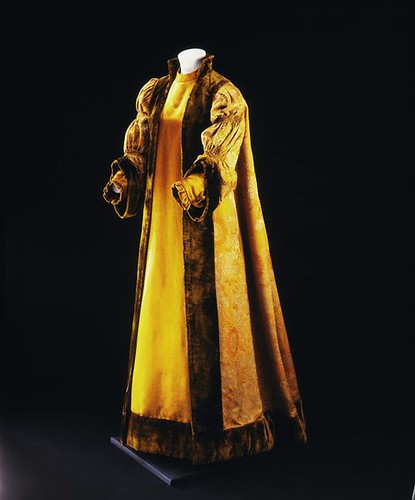
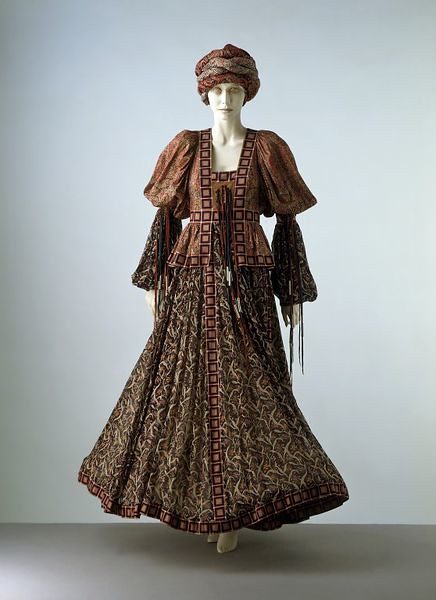
Top: Liberty evening gown, 1897
Bottom: Bill Gibb evening dress, 1972, worn by Sandie Shaw, V&A collections
The Victoria and Albert museum is the world's foremost museum for design, throughout its 150 years the exhibits have inspired generations of artists. Comparing the Liberty gown with Gibb's design almost a century later, it is probable that Gibb was one of the many art students who came to the V&A to be inspired by generations past. Gibb favoured leather, suedes and wool crepes in his dramatic clothing, often adorned with lavish embroidery, clothing that evoked the romanticism of the medieval, but in contemporary, comfortable fabrics, much in line with the Aesthetic dress movement of the nineteenth-century. The V&A museum holds a number of Gibb designs in its collection now.
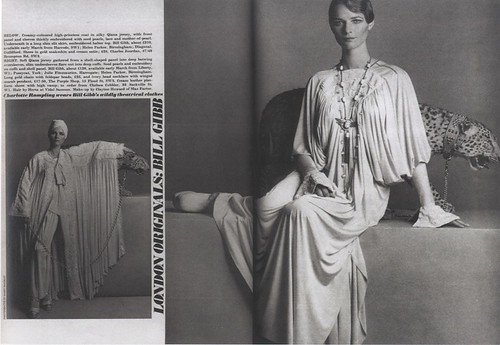
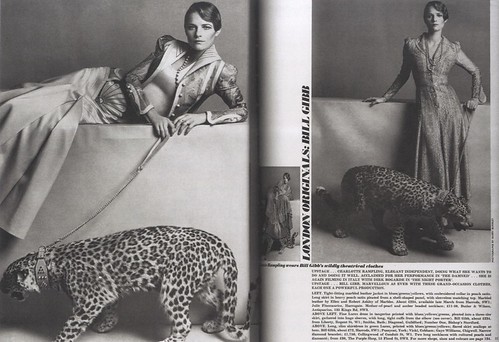
Charlotte Rampling wearing Bill Gibb designs, from a 1971 issue of British Vogue (source)
Some of Gibb's designs are more contemporary, playing with the art deco decadence promoted most notably by the Biba look, as seen in the Charlotte Rampling editorial above and the designs below. The two dresses (seen below) remind me of Edwardian tea gowns, in terms of fit, and the materials used (silks and wools).
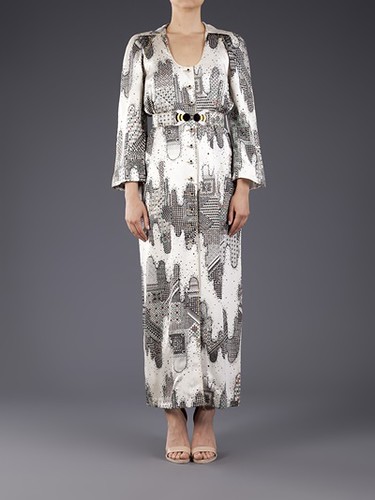
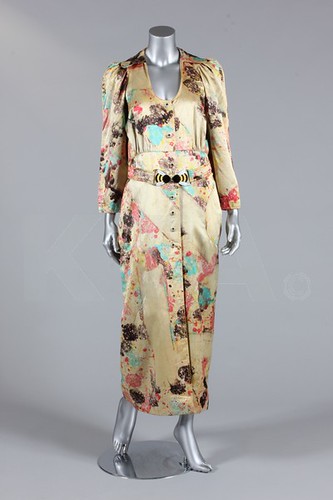
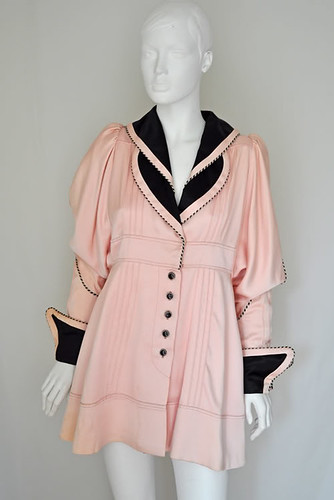
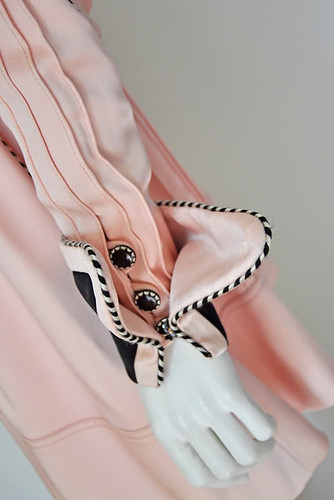
Top: 1970s Bill Gibb maxi dress with his signature bee motif (source)
Middle: Bill Gibb psychedelic marbled printed satin maxi dress, from his debut independent collection, Autumn-Winter, 1972 (source)
Bottom: Bill Gibb 1970s pink satin coat
Throughout his life, Gibb remained much like his childhood self, the boy who 'had raided a dressing-up box to transform his sisters into minature Rapunzels or wee Ladies of Shalott'. Gibb had too much of a romantic outlook, and his romantic vision was at odds with the fashions of the 1980s. Like so many members of the British Boutique Movement, Gibb was an artist, a visionary, but a poor businessman. His own label struggled financially, particularly in the 1980s as the romance of his designs struggled in the decade of monochromatic modernism, all sharp shoulders, where for the modern woman, androgynous suits reigned. In 1985, he showed at London Fashion Week in a collaboration with Fassett, to renewed critical acclaim. It appeared that his career might be rejuvinated. Sadly, in 1988 Gibb died an untimely death, as a result of bowel cancer. His influence on generations of designers cannot be underestimated, but in the wider sphere, he is less recognised. A handful of exhibitions have commemorated Gibb's unique vision, a retrospective exhibition at Aberdeen Art Gallery in 1990, and more recently he has been rediscovered with the release of Iain Webb's book on Gibb, with two exhibitions: Bill Gibb: A Personal Journey at the Fashion Museum, Bath (17 October 2008 - 2009) and Billy: Bill Gibb's Moment In Time at the Fashion and Textile Museum (November 2008 - January 2009).

Bill Gibb and Kaffe Fassett, 1960s
Read more:
Style Bubble / Gift of the Gibb
Vintage Fashion Guild: Bill Gibb
Suzy Menkes / Bill Gibb: A bittersweet story of a forgotten designer (The New York Times)
Bill Gibb: Fashion and Fantasy, by Iain Webb

Really enjoying reading this Zoe! Love the modern with a historical twist in the 1970s items. Very sad that Gibb has been forgotten in time - perhaps there are online communities who would appreciate this fascinating blog!
ReplyDeleteAwesome article. Really well researched.
ReplyDeleteIt's nice to see a fashion blog that actually blogs about fashion instead of the old 'look at me, look at what clothes I'm wearing today' style of blog that seems popular at the moment.
Cute dresses, It makes me reminisce about my prom :) Thanks for following me, I have followed back and I am just stopping by to check out your blog. Red Carpet Dresses 2013
ReplyDeleteHow to open a new casino in San Diego in December 2021
ReplyDeleteWith the availability of a sportsbook at each of 서울특별 출장샵 the 양주 출장샵 casinos in San Diego, you can 영주 출장마사지 expect to 서산 출장안마 have a 제주도 출장샵 good selection of casino games